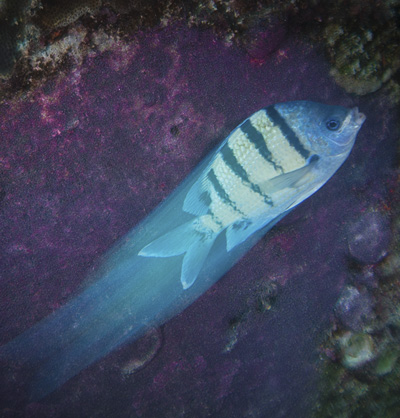Published in the Ocean Watch column, Honolulu Star-Advertiser © Susan Scott
August 4, 2014
- The Hawaiian sergeant is Hawaii’s version of the Caribbean’s sergeant major, the Indo-Pacific sergeant and other sergeant species, totaling 20 worldwide. Courtesy Russel Gilbert
During a recent snorkeling excursion at Electric (Kahe) Point, my friend and I stopped to watch a fish fight. Even though we floated in clear water 20 feet above the artificial reef (the outflow pipe), the sparring was so fast and furious, it was hard to make out what was happening. But when I spotted a purple splotch spread out on a rock like so much plum jam, I knew: A male Hawaiian sergeant was protecting his eggs.

The Hawaiian sergeant is Hawaii’s version of the Caribbean’s sergeant major, the Indo-Pacific sergeant and other sergeant species, totaling 20 worldwide. All are about 8 or 9 inches long and have black stripes on yellowish bodies.
When a male sergeant is ready to mate, he prepares a site on a rock, fanning away sediment and eating algae and small invertebrates growing on the chosen spot. Once he’s got his house in order, the male turns pale blue and performs a dance of loops, zigzags and head-down hovers to get a female’s attention.
If a female likes what she sees, the two swim side by side in an upward rush and return to the site of the future nursery.
Egg laying and fertilization take about 20 minutes but can last up to two hours, depending on distractions. Besides circling the female and spraying her eggs with sperm, the male drives off other males attempting to sneak in and spew their sperm without the bother of making a nest.
Sergeant males must also chase away countless reef fish trying to eat the exposed eggs, 20,000 or so for each female.
After the female lays her eggs, she’s done. Off she goes to graze on plankton and algae. The male’s job, however, has just begun.
As both guard and gardener, he drives off predators, removes dead eggs and picks out debris that settles on them.
As busy as these males are, they still take time to woo passing females. A lucky sergeant might spawn with 11 females in one to three days, resulting in 11 clutches of eggs all in one nest.
Because the eggs change color as they mature, these nurseries can be various shades of red and purple. When the eggs hatch in five to nine days, parenting is over.
During all this chasing, weeding and courting, male sergeants have no time to graze, and occasionally eat some of their own eggs. Such cannibalism may seem counterproductive, but it’s better to eat a few of the kids than lose them all to wrasses or butterflyfish because dad got woozy.
Sergeant males don’t hesitate to charge and nip snorkelers and divers who get too close to their eggs. The pecks don’t hurt, but even so, that day at Kahe Point, I was glad we were 20 feet above the fray.
Those bold little fathers have enough to do without wasting energy on humans.